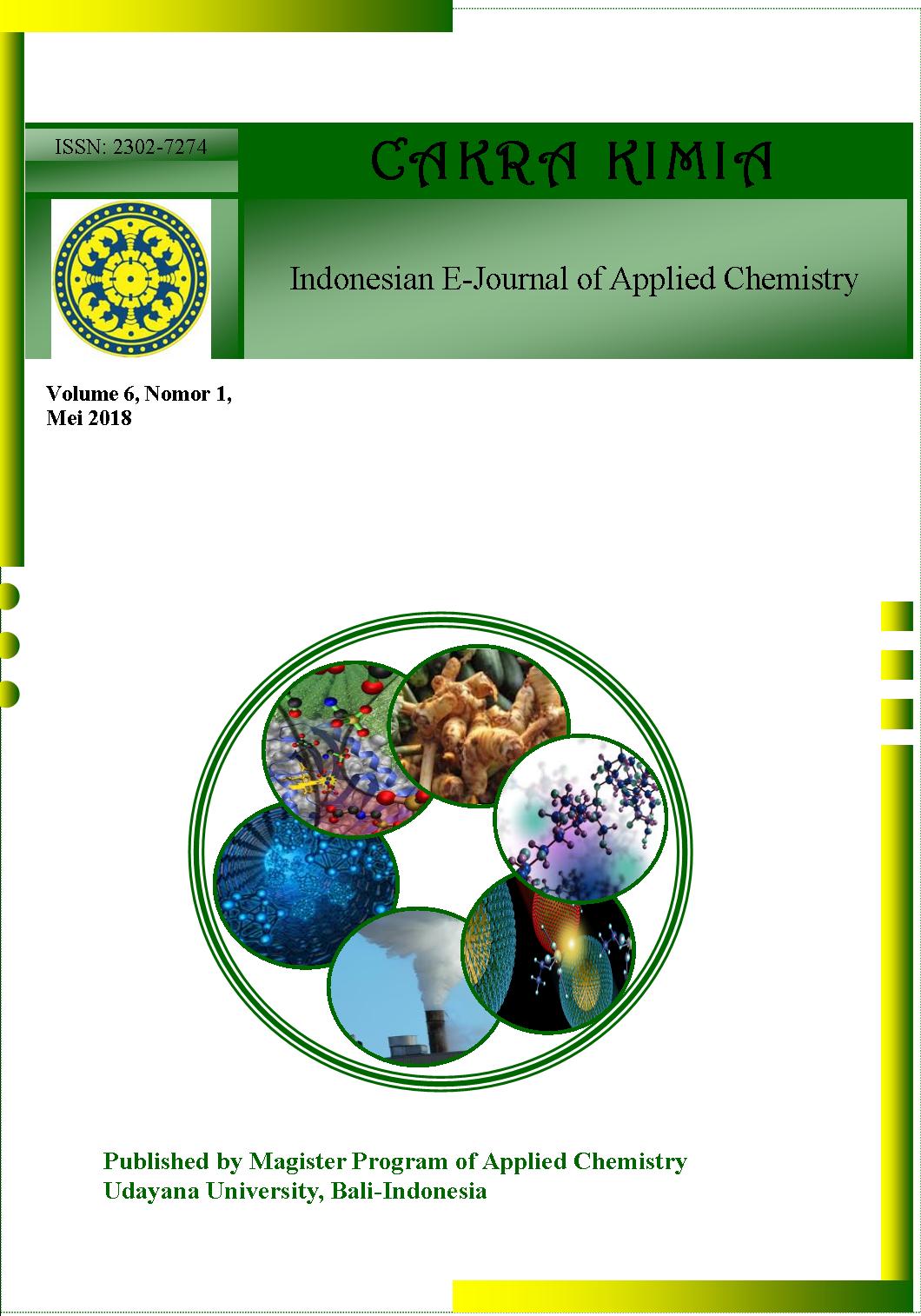AKTIVITAS ANTIOKSIDAN SENYAWA FLAVOOID PADA EKSTRAK n-BUTANOL DAUN CENDANA DAN POTENSINYA SEBAGAI AGEN ANTIKANKER DENGAN METODE BRINE SHRIMP LETHALITY TEST
Abstract
ABSTRAK: Radikal bebas yang berlebihan dalam tubuh dapat menimbulkan berbagai masalah kesehatan seperti kanker dan penyakit degeratif lainnya. Senyawa flavonoid diketahui memiliki aktivitas antioksidan sehingga dapat meredam dan mencegah kerusakan sel akibat reaksi radikal bebas. Cendana (Santalum album, L) merupakan salah satu tumbuhan obat Indonesia yang secara tradisional telah digunakan untuk mengatasi berbagai macam penyakit. Penelitian ini bertujuan untuk mengevaluasi aktivitas antioksidan senyawa flavonoid pada ekstrak n-butanol daun cendana dan potensinya sebagai agen antikanker dengan uji toksisitas menggunakan metode Brine Shrimp Lethality Test (BSLT). Ekstraksi daun cendana dilakukan dengan maserasi menggunakan metanol. Ekstrak metanol yang diperoleh selanjutnya difraksinasi dengan n-heksana, kloroform, dan n-butanol. Ekstrak n-butanol yang mengandung flavonoid kemudian ditentukan kandungan total flavonoidnya, dipisahkan dan dimurnikan menggunakan teknik kromatografi kolom. Evaluasi aktivitas antioksidan dilakukan secara in vitro dengan metode DPPH (1,1-diphenyl-2- picrylhidrazyl) dan uji toksisitas dilakukan menggunakan larva Artemia salina Leach sebagai bioindikator. Hasil maserasi 500 g serbuk cendana diperoleh 30,17 g ekstrak pekat metanol. Fraksinasi 25 g ekstrak pekat metanol menghasilkan berturut-turut 3,39 g ekstrak pekat n-heksana, 3,41 g ekstrak kloroform, 7,73 g ekstrak n-butanol dan 9,11 g ekstrak pekat air. Hasil uji fitokimia menunjukkan ekstrak n-butanol mengandung flavonoid. Pemisahan dengan kromatografi kolom menghasilkan 6 fraksi gabungan (F1, F2, F3, F4, F5, dan F6). Fraksi F3 yang mengandung flavonoid menunjukkan aktivitas antioksidan dengan IC50 sebesar 182,73 ppm dan bersifat toksik terhadap larva Artemia salina Leach dengan LC50 sebesar 158,49 ppm sehingga berpotensi sebagai agen antikanker.
Kata kunci: daun cendana, Santalum album, L, flavonoid, toksisitas, antioksidan
ABSTRACT: Exeessive amount of free radical in the body can generate many health problems including cancer, cardiovascular and others. Flavonoid compounds have been reported to have ability in scavenging and preventing our body from cell damage cause by free radicals. Cendana (Santalum album L.) is one of Indonesian traditional plant that has tradtionally been used to treat various diseases. This study was aimed to evaluate the antioxidant activity and toxicity of the flavonoid compounds present in n-buthanol extract of leaf Cendana. Extraction of Cendana leaf powder was done by maceration with methanol. The Crude methanol extract was then fractionated with n-hexane, chloroform, and n-buthanol respevtively. n-buthanol extract possesing flavonoid was further separated and purified into silica gel column chromatograpphy. Antioxidant activity was determined using DPPH method (1,1-diphenyl-2- picrylhidrazyl) and tocixcity test was performed using Brine Shrimp Lethality Test (BSLT) with Artemia salina Leach as bioindicator. Extraction of 500 g leaf powder cendana yielded 30.17 g of crude methanol extract. Fractionation of 25 g crude methanol extract gave 3.39 g n-hexane,3.41 g chloroform, 7.73 g of n-buthanol and 9.11 g of water extracts respectively. Flavonoid compound was presence in n-buthanol extract. Flash column chromatography separation of n-buthanol extract gave 6 fractions (F1, F2, F3, F4, F5, and F6). Fraction F3 exhibiting the flavonoid compound showed antioxidant activity with IC50 of 182.73 ppm and toxic to Artemia salina Leach larvae with LC50 value of 158.49 ppm, hence it is potential as anticancer agent.
Keywords: Santalum album, L., flavonoid, toxicity, antioxidant
Downloads
References
[2] Sukardiman, Cholies N.Z., Sismindari. 2006. Induksi Apoptosis dan Peningkatan Ekspresi p53, Bax serta Aktivasi Enzim Caspase Sel Kanker Payudara Manusia oleh 5-hydroxy-7-ethoxy-flavanones dari Kaempferia pandurata Roxb. Laporan Penelitian Hibah Bersaing Tahun I, Lembaga Penelitian Universitas Airlangga.
[3] Ren, W., Qiao, Z., Wang, H., Zhu, L., and Zhang, L., 2003, Flavonoids: Promising Anticancer Agents. Medicinal Research Review. 23(4): 519-53.
[4] Muaja, A.D., Koleangan, H.S.J., dan Runtuwene, M.R.J. 2013. Uji Toksisitas dengan Metode BSLT dan Analisis Kandungan Fitokimia Ektrak Daun Soyogik (Saurauia bracteosa DC) dengan Metode Soxhletasi. Journal of Biochemistry. 2(2): 115-118.
[5] Hasan, A.E.Z., Purnamasari, A., dan Wardatun S. 2013. Uji Toksisitas, Aktivitas Antioksidan dan Penentuan Kadar Flavonoid Total Ekstrak Etanol 70% Propolis serta Serbuk Nanopropolis. Jurnal Teknologi Industri Pertanian. 23(1): 13-21.
[6] Rahayu, S., Wawo, A.H., Noordwijk, M.V., and Hairiah, K. 2002. Cendana. Kupang. Balai Kehutanan.
[7] Prasad, M.P.,Soumya, M., and Brinda. 2014. Phytochemical Screening and In-Vitro Evaluation of Anti-oxidant and Anti-bacterial Properties of Medicinal Plants. Journal of Biotechnology.3(1): 18-25.
[8] Putra, I.W.P.E., Santi, S.R, dan Rustini, N.L. 2016. Isolasi dan Identifikasi Senyawa Sitotoksik Daun Nagasari (Calophyllum nagassarium Burm. f.) terhadap Larva Artemia salina Leach. Jurnal Kimia. 10(1): 96-102.
[9] Molyneux, P. 2004. The Use of The Stable Free Radical Diphenylpicryl-hydrazil(DPPH) for Estimating Antioxidant Activity. Songklanakarin J. Science Tecnology. 26(2): 211-219.
[10] Yuhernita dan Juniarti. 2011. Analisis Senyawa Metabolit Sekunder Dari Ekstrak Metanol Daun Surian Yang Berpotensi Sebagai Antioksidan. Makara Sains.15(1): 48-52.
[11] Annabi, B., Bouzeghrane, M., Currie, J.C., Hawkins, R., Dulude, H., Daigneault, L., Ruiz, M., Wisniewski, J., Garde, S., Rabanni, S.A., Panchal, C., Wu, J.J., and Beliveau, R. 2005. APSP94-Derived Peptide PCK3145 Inhibits MMP-9 Secretion and Triggers CD44 cell Surface Shedding: Implication In Tumor Metastatis.Clinical and Experimental Metastait. 22(8): 429-43



 Petunjuk Penulisan
Petunjuk Penulisan
